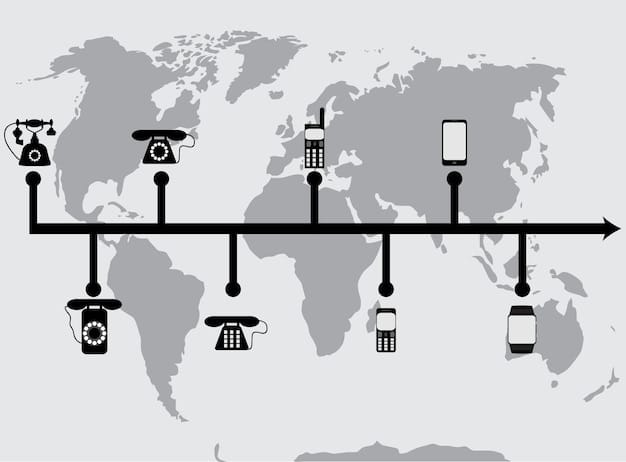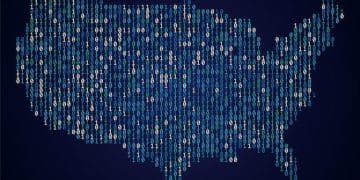Blockchain’s Role in US Supply Chain Security: A Practical Guide

The adoption of blockchain technology offers a robust solution for enhancing the security, transparency, and efficiency of US supply chains, addressing vulnerabilities through immutable ledgers and real-time data.
In an increasingly interconnected world, the resilience of supply chains is paramount, and for the United States, safeguarding these intricate networks is a matter of national economic and security interest. This article delves into The Role of Blockchain Technology in Securing US Supply Chains: A Practical Guide, exploring how distributed ledger technology can revolutionize the way goods move, information flows, and trust is established across complex global and domestic logistics operations.
Understanding Supply Chain Vulnerabilities in the US Context
The intricate web of US supply chains, from raw materials to consumer goods, faces myriad vulnerabilities. Disruptions can arise from natural disasters, cyberattacks, geopolitical tensions, or even simple human error. The interconnectedness, while offering efficiency, also amplifies the impact of any single point of failure. This section explores these inherent weaknesses and sets the stage for how emerging technologies might offer resilience.
Traditional supply chain models often rely on centralized databases and fragmented communication, leading to opacity. This lack of clear visibility from end-to-end makes it difficult to pinpoint the origin of issues, verify product authenticity, or ensure ethical sourcing. The sheer volume of transactions and participants further complicates oversight, creating opportunities for fraud, counterfeiting, and inefficient processes that stifle economic growth and consumer confidence.
Key Vulnerabilities Identified
Several critical areas within US supply chains are particularly susceptible to disruption and inefficiency. Addressing these points is crucial for building a more resilient system.
- Lack of Real-time Visibility: Many systems still operate with significant data lags, making it challenging to track goods instantaneously or respond swiftly to disruptions.
- Data Silos and Fragmentation: Information often resides in disparate systems that don’t communicate effectively, leading to inconsistencies and errors.
- Counterfeiting and Illicit Trade: The absence of robust, verifiable tracking mechanisms makes it easier for counterfeit goods to enter the market, posing risks to consumers and legitimate businesses.
- Cybersecurity Threats: Centralized databases are attractive targets for cybercriminals, potentially compromising sensitive data and disrupting operations.
The human element also plays a significant role in vulnerabilities. Reliance on manual data entry, paper-based processes, and individual trust relationships can introduce errors and create opportunities for malicious activities. Furthermore, the global nature of many US supply chains means they are exposed to varying regulatory environments and geopolitical instabilities, adding layers of complexity to security and oversight.
A comprehensive understanding of these vulnerabilities is the first step toward implementing proactive solutions. The goal is not merely to react to disruptions but to build a framework that inherently resists them, ensuring continuous flow and integrity of goods and information.
The Core Principles of Blockchain Technology for Supply Chains
Blockchain, at its essence, is a distributed, immutable ledger that records transactions in a secure and transparent manner. When applied to supply chains, these core principles translate into powerful capabilities that can mitigate many of the vulnerabilities discussed previously. Each “block” contains a timestamped batch of transactions, which, once validated, is added to a chain of previous blocks, creating an unchangeable record.
This distributed nature means there is no single point of failure or control, making the network highly resilient to attacks or disruptions. Participants in the network can access the same validated information, fostering a new level of trust and collaboration without relying on a central authority. This paradigm shift from centralized control to decentralized consensus is what truly differentiates blockchain from traditional database systems.
Immutability and Transparency
One of the most compelling aspects of blockchain is its immutability. Once a transaction is recorded on the ledger, it cannot be altered or deleted. This property is invaluable for maintaining the integrity of product provenance, ownership transfers, and compliance records throughout the supply chain life cycle. Consider the implications for verifying the origin of food products or tracking the components of complex machinery.
- Enhanced Traceability: Every stage of a product’s journey, from production to delivery, can be securely logged, providing an auditable trail.
- Reduced Fraud: The unalterable nature of records makes it significantly harder to introduce counterfeit goods or fraudulent documents into the supply chain.
- Improved Compliance: Regulatory requirements and certifications can be securely attached to products, streamlining audits and ensuring adherence to standards.
Transparency, while often misunderstood as complete public visibility, typically means controlled transparency in a private or permissioned blockchain. Participants gain access to relevant data based on their roles and permissions, enabling them to verify information without revealing sensitive proprietary details to everyone. This selective transparency builds trust among authorized parties, optimizing processes and resolving disputes more efficiently.
Understanding these foundational principles is key to appreciating how blockchain technology fundamentally redefines trust and operational efficiency in complex logistical networks. It moves beyond incremental improvements, offering a transformative framework for managing information and assets.
Practical Applications: How Blockchain Secures Supply Chains
The theoretical benefits of blockchain technology translate into tangible, practical applications that address core security challenges in US supply chains. From preventing counterfeiting to optimizing customs clearance, blockchain offers a versatile toolkit for enhancing integrity and efficiency. These applications move beyond mere data storage, focusing on creating verifiable and actionable insights that strengthen the entire chain.
One significant area is product traceability. By recording each step of a product’s journey on a blockchain, companies can create a digital fingerprint for every item. This allows for instant verification of origin, components, and handling conditions. In industries like pharmaceuticals or food, this can be critical for public safety, enabling rapid recalls of contaminated products or preventing the distribution of fake drugs.
Combatting Counterfeiting and Fraud
Counterfeiting is a multi-billion dollar problem that poses risks to consumers and undermines brands. Blockchain provides a robust defense mechanism by creating an unforgeable record of authenticity. Each genuine product can be associated with a unique digital identity on the blockchain, verifiable by anyone with the necessary permissions.
- Serialization and Unique Identification: Assigning a unique, cryptographic ID to each product that is then registered on the blockchain.
- Provenance Tracking: Recording every transfer of ownership and key event in a product’s lifecycle, from manufacturing to retail.
- Consumer Verification: Empowering consumers to scan QR codes or NFC tags to verify a product’s authenticity instantly.
Beyond counterfeiting, blockchain mitigates various forms of fraud, including document forgery and tampering with transit records. Smart contracts, self-executing agreements whose terms are directly written into code, can automate payments and conditional releases of goods, reducing human intervention and the potential for fraudulent manipulation. The immutable record provides a forensic trail, making it easier to investigate discrepancies and hold parties accountable.

Another crucial application lies in improving transparency and ethical sourcing. Consumers are increasingly demanding to know where their products come from and whether they were produced ethically. Blockchain can provide an undeniable record of compliance with labor laws, environmental standards, and quality certifications, building consumer trust and brand reputation. This granular level of insight extends to managing returns and warranties, streamlining processes and enhancing customer satisfaction. The efficiency gains in logistics, such as reduced paperwork and faster customs clearance due to verifiable digital documents, further contribute to a more secure and responsive supply chain.
Challenges and Considerations for Blockchain Adoption
While the potential of blockchain technology in securing US supply chains is immense, its widespread adoption is not without challenges. Implementing such a transformative technology requires careful planning, significant investment, and a collaborative spirit across various stakeholders. Understanding these hurdles is crucial for developing realistic implementation strategies.
One primary concern revolves around scalability. Current blockchain networks, especially public ones, can struggle with the sheer volume of transactions required for global supply chains. Private or permissioned blockchains offer better scalability but require careful design to maintain decentralization and trust among chosen participants. Interoperability between different blockchain systems, and between blockchain and legacy systems, represents another complex technical hurdle that needs to be addressed.
Regulatory and Legal Complexities
The regulatory landscape for blockchain is still evolving, posing uncertainties for businesses looking to implement the technology. Issues such as data privacy (especially regarding GDPR and other similar regulations), jurisdiction for dispute resolution across international borders, and legal recognition of smart contracts need clearer frameworks.
- Data Privacy: Ensuring compliance with evolving data protection laws while maintaining transparency and traceability.
- Smart Contract Enforceability: Establishing legal precedents and frameworks for the enforceability of self-executing smart contracts.
- Cross-Border Governance: Developing international standards and agreements for blockchain use in global trade.
The initial investment in blockchain infrastructure, including hardware, software, and talent, can be substantial. Many companies, particularly small and medium-sized enterprises (SMEs), might find these costs prohibitive. Furthermore, integrating blockchain with existing enterprise resource planning (ERP) systems, warehouse management systems (WMS), and other legacy technologies is a complex undertaking that requires specialized expertise and significant customization.
Resistance to change within organizations and across supply chain partners also presents a significant challenge. Adopting blockchain requires a shift in mindset, from competitive secrecy to collaborative transparency, which can be difficult to achieve. Building consensus among diverse stakeholders, each with their own interests and priorities, is essential for successful implementation. Addressing these issues through pilot programs, phased rollouts, and clear communication can pave the way for broader adoption.
Building a Resilient Supply Chain with Blockchain: A Step-by-Step Guide
Transitioning to a blockchain-enabled supply chain model requires a structured approach. It’s not merely about installing new software; it’s about re-engineering processes, fostering collaboration, and establishing trust among all participants. This guide outlines key steps for organizations looking to leverage blockchain for enhanced security and resilience in their US supply chains.
The journey often begins with a thorough assessment of current supply chain vulnerabilities and objectives. What specific problems is blockchain intended to solve? Is it counterfeiting, lack of traceability, inefficient payment processes, or compliance issues? Clearly defining the scope and expected outcomes helps in selecting the right blockchain solution and ensuring a focused implementation.
Phased Implementation Strategy
Rather than attempting a complete overhaul, a phased approach is generally more practical and less risky. Start with a pilot project focused on a specific, high-value problem area or a limited segment of the supply chain.
- Define Scope and Participants: Identify a manageable segment of the supply chain and key partners willing to participate in the pilot.
- Choose the Right Blockchain Platform: Select a platform (e.g., Hyperledger Fabric, Ethereum, VeChain) that aligns with the project’s requirements for privacy, scalability, and functionality.
- Integrate with Existing Systems: Plan for seamless integration with ERP, WMS, and other legacy systems to avoid disrupting current operations.

Education and training are vital for all stakeholders. Understanding how blockchain works, its benefits, and its operational implications will foster acceptance and facilitate a smoother transition. This includes training on new data entry protocols, monitoring tools, and dispute resolution mechanisms within the blockchain framework. Establishing clear governance models and consortium rules among participants is also crucial for long-term success, ensuring fair access, data privacy, and dispute resolution mechanisms.
Regular auditing and performance monitoring are essential after implementation to ensure the blockchain solution is delivering the intended benefits and to identify areas for improvement. As the system matures, consider scaling up to include more participants and encompass broader segments of the supply chain. This iterative process allows for continuous optimization and adaptation, ultimately building a truly resilient and secure supply chain network that can withstand future disruptions and challenges.
The Future Outlook: Blockchain’s Transformative Impact
The trajectory of blockchain technology in US supply chains points towards a future where transparency, efficiency, and trust are not aspirations but systemic realities. As the technology matures and regulatory frameworks adapt, its transformative impact will extend beyond individual companies, reshaping entire industries and fostering a more resilient global trade ecosystem. The initial high costs and complexities are expected to decrease as solutions become more standardized and accessible, making adoption feasible for a wider range of businesses.
We are likely to see increased interoperability between different blockchain networks, allowing for seamless data exchange across diverse supply chains and sectors. This “internet of blockchains” will facilitate a new level of collaboration and efficiency, where information can flow securely from one end of the global trade network to the other without friction. The integration of blockchain with other emerging technologies, such as Artificial Intelligence (AI) and the Internet of Things (IoT), will further amplify its capabilities.
Emerging Trends and Synergies
The combination of blockchain’s immutable ledger with real-time data from IoT sensors and AI-driven analytics offers unprecedented insights into supply chain operations. This synergy can enable predictive maintenance, optimized routing, and proactive risk management.
- IoT Integration: Sensors on products or in transit can automatically record data (temperature, location, humidity) directly onto the blockchain, providing real-time, verifiable conditions.
- AI for Predictive Analytics: AI algorithms can analyze blockchain data to predict potential disruptions, optimize inventory levels, and identify patterns of fraud.
- Digital Twin Technology: Creating virtual replicas of physical products or processes on the blockchain, allowing for comprehensive monitoring and simulation.
The long-term vision involves fully digitized, autonomous supply chains where smart contracts automate most processes, from order placement and payment to customs clearance and delivery. This ecosystem would significantly reduce human error, speed up transactions, and unlock substantial cost savings. Furthermore, blockchain’s role in creating verifiable digital identities for products and individuals will strengthen global efforts against illicit trade, ensuring ethical sourcing and environmental sustainability.
While the path to this future may present ongoing challenges, the foundational promise of blockchain – decentralized trust and immutable records – remains a powerful driver for innovation. Its ability to create robust, transparent, and efficient supply chains will be a cornerstone of economic stability and growth for the US and the global economy in the decades to come, moving from a reactive response to proactive resilience.
Regulatory Harmony and Digital Trust
The successful and widespread adoption of blockchain in securing US supply chains hinges not only on technological advancement but also on the cultivation of regulatory harmony and the establishment of robust digital trust frameworks. Without clear legal guidelines and a universally accepted understanding of digital assets and transactions, the full potential of blockchain remains constrained. This section explores the critical interplay between policy, law, and the underlying technology to foster an environment conducive to blockchain-driven supply chain security.
Governments, industry bodies, and international organizations are increasingly recognizing the need for consistent regulatory approaches to blockchain. This includes clarity on data ownership, privacy, cross-border data flows, and the legal standing of smart contracts. Disparate regulations across states or nations create friction and hinder seamless integration, which is antithetical to the very purpose of a distributed ledger that transcends traditional geographical boundaries.
Building Legal Frameworks
Developing adaptable legal frameworks that embrace the unique characteristics of blockchain, such as immutability and decentralization, is paramount. This involves modernizing existing laws and creating new ones that address issues like the legal recognition of tokenized assets and the implications of decentralized autonomous organizations (DAOs).
- Uniform Commercial Code Updates: Adapting traditional legal codes to encompass digital assets and blockchain transactions.
- International Cooperation: Forging multilateral agreements to standardize blockchain regulations for global trade and logistics.
- Consumer Protection Laws: Ensuring that blockchain applications in supply chains comply with consumer rights regarding data privacy and product authenticity.
The concept of digital trust extends beyond technological security; it encompasses the confidence that participants have in the system, the data it holds, and the processes it automates. This trust is built on transparency, auditability, and the enforceability of agreements. Blockchain’s inherent attributes contribute significantly to this, but legal and policy frameworks solidify it, providing recourse and certainty in commercial interactions.
Furthermore, the development of industry standards and best practices will play a crucial role. These voluntary guidelines, developed by consortia and industry leaders, can address technical, operational, and ethical considerations, providing a blueprint for secure and interoperable blockchain implementations. By aligning technological innovation with progressive regulation and a shared commitment to digital trust, the US can position its supply chains at the forefront of security and efficiency, leveraging blockchain to its fullest capacity.
| Key Aspect | Brief Description |
|---|---|
| 🔗 Enhanced Traceability | Blockchain provides an immutable record of product journeys, improving transparency and origin verification across the supply chain. |
| 🛡️ Fraud Prevention | Cryptographic security and immutability significantly reduce counterfeiting and illicit trade activities. |
| ⚡ Operational Efficiency | Streamlines processes, reduces paperwork, and automates transactions via smart contracts for faster operations. |
| 💡 Future Integration | Synergies with IoT and AI promise advanced analytics and real-time monitoring for proactive supply chain management. |
Frequently Asked Questions
Blockchain is a distributed, immutable ledger that records transactions securely and transparently. In supply chains, it creates an unchangeable record of every step a product takes, from origin to consumer. This enhances traceability, verifies authenticity, and improves overall visibility across the network.
Blockchain combats counterfeiting by assigning unique digital identities to products, logging their entire lifecycle on an immutable ledger. This allows for instant verification of authenticity, making it extremely difficult for fake products to infiltrate the supply chain and reach consumers.
Key challenges include scalability issues, achieving interoperability between different blockchain and legacy systems, significant initial investment costs, and the need for clear regulatory frameworks. Additionally, fostering collaboration among competing supply chain partners can be difficult.
Absolutely. Blockchain can be integrated with IoT devices to automatically record real-time data (e.g., temperature, location) onto the ledger. AI can then analyze this blockchain data to offer predictive insights, optimize logistics, and enhance overall supply chain intelligence and efficiency.
Long-term benefits include significantly increased transparency, reduced fraud, improved operational efficiency through automation via smart contracts, and enhanced consumer trust. Ultimately, blockchain contributes to building supply chains that are more resilient to disruptions and adaptable to future challenges.
Conclusion
The journey toward fully integrated, secure, and transparent US supply chains is complex, but blockchain technology offers a compelling and practical pathway. By decentralizing trust, ensuring data immutability, and enabling real-time visibility, blockchain addresses many of the inherent vulnerabilities plaguing traditional supply chain models. While challenges related to scalability, interoperability, and regulatory clarity persist, the proven benefits in areas like anti-counterfeiting, enhanced traceability, and operational efficiency underscore its indispensable role. As the technology matures and collaborative efforts among stakeholders deepen, blockchain is set to be a cornerstone in building future-proof supply chains that are not only secure but also remarkably resilient, adaptable, and a driving force for economic stability and growth.





